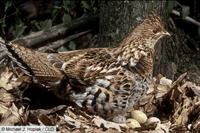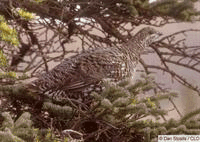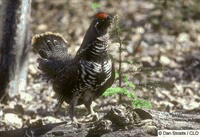 |
|
| Home Page More News | |
| In da Woods | |
| by Melanie B. Fullman, US Forest Service | |
 |
 |
| above: Ruffed Grouse | Female - crest on head and tail |
|
|
 |
| above: Spruce Grouse Male | Female |
|
The Partridge Family
If you’ve spent much time in the woods lately, you’ve probably noticed a LOT of grouse! Fluctuating in rather predictable 10 year cycles, the current population certainly seems to be at a high point. Whether you like to hunt grouse with a shotgun or camera, this autumn is excellent for finding our resident “partridge” or as some call them, simply “birds”. Ruffed grouse, Bonasa umbellus, are in the same family as turkeys, pheasants, quail, and domestic chickens (so they really DO taste like chicken!). They are native, year-round residents of boreal forests – colder environments with large stands of spruce, fir, aspen, and paper birch. As such, the North Woods is actually at the southern end of their range. Generally, ruffed grouse live throughout Canada, the northern US, and higher elevations of the Appalachian and Rocky Mountains. Population Swings Both the high peaks and low troughs of their population swings can be broad or abrupt. Declines are largely triggered by rises in the predator populations that typically follow the grouse cycle by a year or so. In addition to people, hawks, owls, fishers, coyotes, bobcats, raccoons, skunks, crows, and ravens find either adult grouse or their eggs tasty! Higher populations of grouse also enable easier transmission of diseases and parasites as the birds meet other grouse more readily (like kids going back to school). In some places, grouse may even eat themselves out of their food supply. In response to heavy munching of their buds, trees sometimes produce chemicals that make the buds bitter and/or difficult to digest. Eventually, food depletion leads to individual weaknesses, which make grouse more susceptible to hypothermia or capture. Within a few years, grouse numbers plummet. Then, as conditions improve, from a drop in predators and increase in food, the population rebounds. With up to 12 eggs per clutch, a favorable spring may allow extremely rapid growth of an entire grouse community in just one year. Aspen = Grouse Across the Ottawa National Forest, certain stands are being managed specifically for younger-aged aspen. This includes the Moraine & Bluebill Aspen Management Areas on the Bessemer District, with most trees currently about 10 years old – the peak age for high quality grouse habitat. The Harris Creek area, also on the Bessemer Ranger District, is slightly older (20-25 years) but still has lots of excellent grouse habitat. In each of these areas – Bluebill Creek, Moraine Lake, and Harris Creek – the District has developed and maintains a series of hiking trails to improve grouse viewing and hunting. In the past few weeks, all of these “hunter walking trails” have been mowed. The trails are also gated since they are NOT open to ATVs. The walking-only designation is in response to the dozens of grouse hunters that expressed a desire to have non-motorized opportunities. Folks that wish to hunt grouse from ATVs are, of course, welcome to ride any of the hundreds of miles of ATV-designated routes instead. In addition to the 3 areas mentioned, there are 5 other aspen management areas across the Ottawa: Cooks Run (Iron River), Davidson Lakes (Kenton), Interior (Watersmeet), Morrison Creek (Iron River), and Pelkie (Ontonagon). A map packet of all 8 is available at the Forest Headquarters on US 2 in Ironwood at NO charge. Plus, we have free aspen coverage maps of the whole Forest, by District and by age class. These can be picked up at any office or downloaded from the Forest website: go www.fs.usda.gov/ottawa, select Maps & Publications, then scroll to Hunter Maps. Please note, these are BIG files, which may take several minutes to download; they print best on 11x17. Fun for the whole Family Grouse hunting is also relatively cheap. Decent boots, gun or camera, snack, water, map, and compass are all that’s needed. You don’t need expensive equipment, fancy transportation, or a hunting dog. Of course, you should tell someone where you’re going and check State hunting regs. In particular, hunters should be alert for dark, blackish grouse. These are spruce grouse, rare in the North Woods and protected from hunting in both Michigan and Wisconsin. Spruce grouse are most likely to be found in spruce bogs (duh), cedar swamps, and jack pine plains. While the males are not very similar in appearance, spruce grouse hens can be difficult to distinguish from ruffed grouse hens. Ruffed grouse hens have a crest on their heads and a dark band at the bottom of their tail feathers. Please, look twice, shoot once. I hope you and your family will get a chance to meet the Partridge Family this fall. You might even invite them for dinner… |
|
